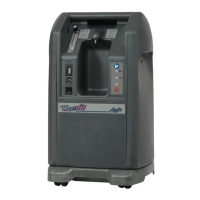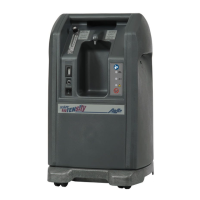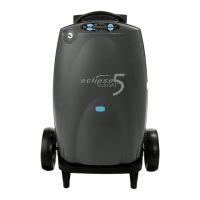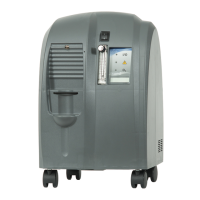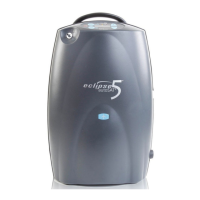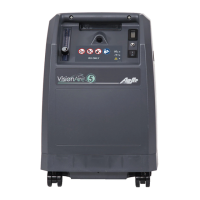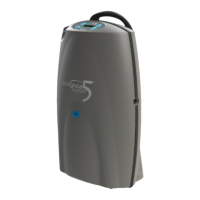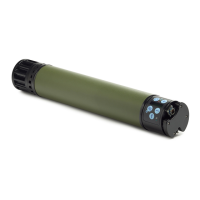The CAIRE NewLife Intensity 10 is an oxygen concentrator designed to provide supplemental oxygen therapy to individuals with various respiratory conditions. It is intended for use in home settings, during travel, or while participating in daily activities away from home. The device is not intended for life support and does not offer patient monitoring capabilities.
Function Description
The NewLife Intensity 10 operates by drawing in ambient room air, which consists of approximately 21% oxygen, 78% nitrogen, and 1% other gases. This air passes through an adsorbent material called molecular sieve, which separates oxygen from nitrogen. The concentrator then delivers a flow of high-concentration oxygen to the user. The device is designed to operate continuously and does not deplete the oxygen in a room.
The NewLife Intensity 10 offers a dual flow option, allowing a single concentrator to meet the high flow requirements of a 10 LPM patient or the needs of two patients simultaneously, with any combination of flows up to 10 LPM. This feature makes it suitable for use in homes, extended care facilities, hospitals, or physician's waiting rooms.
Usage Features
Prescription and Safety:
Oxygen therapy with the NewLife Intensity 10 requires a physician's prescription. Users must only select the prescribed level of oxygen and should not change the flow selection unless directed by a licensed clinician. Unauthorized oxygen therapy can be dangerous. The device is not for life support and users unable to communicate discomfort or understand instructions may require supervision. Back-up oxygen (e.g., cylinder oxygen) is advised in case of power outage or concentrator failure.
Setup and Operation:
To operate the unit, it should be located near an electrical outlet in the room where the user spends most of their time. It must be positioned away from curtains, drapes, hot air registers, heaters, and fireplaces, with at least 12 inches (30.5 cm) of clearance on all sides to prevent obstruction and overheating. The operating controls should be easily accessible, and the air intake on the back of the unit must not be obstructed.
After unwrapping the power cord, it is inserted into an electrical outlet. The power switch on the front of the unit is then turned to the "on" (|) position. An audible and visual alarm will sound briefly to indicate proper alarm function. The flowmeter adjustment knob is used to set the prescribed oxygen flow rate in liters per minute (LPM), ensuring the ball inside the flowmeter centers on the correct flow line. The flowmeter is marked in 1/2 LPM increments, or 1/8 LPM increments for units with the 2 LPM flowmeter option for settings up to 2 LPM. Users should not adjust the flowmeter clockwise to decrease or shut off oxygen flow unless necessary.
Oxygen Delivery Accessories:
Oxygen accessories such as a humidifier (if prescribed), nasal cannula, face mask, or catheter are connected to the oxygen outlet. A firebreak (CAIRE Part Number 20629671) is required for use with any cannula to stop gas flow in case of ignition. Recommended accessories include:
- Nasal Cannula (CAIRE Part Number CU002-1)
- Humidifier Adaptor Tubing (CAIRE Part Number 20843882)
- Humidifier Bottle (CAIRE Part Number HU003-1 or HU014-1 for Intensity models)
- Oxygen Outlet Adapter (CAIRE Part Number F0025-1, not for use with Intensity 10 LPM)
- Face Mask (CAIRE Part Number MS013-1)
- Humidifier Adapter Extension (CAIRE Part Number HU002-1)
Humidifier Use:
If a humidifier is prescribed, the reservoir bottle is filled with cool or cold water (distilled water preferred) to the indicated fill line, avoiding overfilling. The bottle is then securely screwed back together and connected to the oxygen outlet. Oxygen tubing from the nasal cannula, face mask, or other accessories is connected to the humidifier outlet fitting. If no humidifier is prescribed, oxygen tubing is connected directly to the unit's oxygen outlet using a separate outlet fitting.
Nebulizer Use (for medication inhalation):
For medication inhalation, hands must be washed thoroughly. The prescribed amount of medication is measured using an eyedropper, syringe, or other device and placed into the nebulizer's medication cup. The medication cup is then connected to the nebulizer, and a "T" piece or mouthpiece is attached. One end of the air supply tubing is connected to the air outlet barb fitting, and the other end to the bottom of the nebulizer. The air valve is opened completely. The user then closes their mouth around the mouthpiece (without holding it with teeth), takes a slow, deep breath, pauses for 1-2 seconds, and exhales slowly and completely. This procedure is repeated until the prescribed medication nebulizes or the treatment time elapses. If rest periods are instructed, the air valve should be turned to the OFF position to conserve medication.
Alarm Conditions and Troubleshooting:
The NewLife Intensity 10 features several low-priority alarms:
- General malfunction yellow light and intermittent audible alarm: Indicates high or low product tank pressure, high device temperature, or no flow (for 10 LPM Single Flow Meter Only). Users should ensure the flowmeter is open, cannula is not kinked, no devices are obstructing the outlet, the unit has proper clearance, the intake filter is clean, and the unit is within operating temperature. If the issue persists, the equipment provider should be contacted.
- Oxygen monitor yellow light (IO2) and intermittent audible alarm: Indicates low oxygen concentration (below 82%). The equipment provider should be contacted. It is normal for this light to turn on for up to five minutes when the unit is first turned on.
- Power failure yellow light and intermittent audible alarm: Indicates a loss of power. Users should ensure the device is plugged into a working outlet and the breaker switch is pushed in. If the issue persists, the equipment provider should be contacted.
If the unit fails to operate properly, users should consult the troubleshooting section of the manual. If the problem cannot be resolved, the equipment provider should be contacted, and a reserve supplemental oxygen supply should be used.
Maintenance Features
Filters:
The NewLife Intensity 10 has an air intake gross particle filter located on the back of the unit, which removes dust and other large particles from the air. This filter should be cleaned at least once a week, or more often depending on operating conditions, by removing it, washing it in a warm solution of soap and water, rinsing thoroughly, removing excess water with a soft, absorbent towel, ensuring it is completely dry, and then replacing it. The unit should not be operated without this filter in place.
Additionally, the unit contains a product filter (for particle size 10 micron or greater) within the oxygen concentrator, which provides additional filtration. Maintenance of this filter is performed by the equipment provider.
Cleaning and Care:
The cabinet, control panel, and power cord should be cleaned only with a mild household cleaner applied with a damp (not wet) cloth or sponge, then wiped dry. No liquid should be allowed inside the concentrator. Special attention should be paid to the oxygen outlet to ensure it remains free of dust, water, and particles. The outer case should not be sprayed directly. The device cabinet should be cleaned at minimum between users.
It is crucial to prevent the oxygen concentrator from getting wet or allowing fluids to enter the unit, as this can cause malfunction, shut down, electrical shock, or burns. Oil, grease, or petroleum-based or other flammable products should not be used with the oxygen-carrying accessories or the concentrator, as oxygen accelerates combustion.
For cleaning the nebulizer after each treatment, separate the nebulizer and mouthpiece assembly, remove the medication cup, and rinse each component thoroughly in warm water. Once a day, all nebulizer parts (excluding air supply tubing) should be cleaned with a mild detergent or soap solution in warm water, rinsed thoroughly, and soaked in a solution of one (1) part white vinegar and three (3) parts water for 30 minutes to disinfect. After soaking, rinse thoroughly with warm water to remove the disinfectant solution, place all parts on a paper towel or soft absorbent material to air dry (do not wipe dry), and store in a clean container or plastic bag when dry.
Cannula Replacement:
The nasal cannula or oxygen tubing should be replaced as recommended by the cannula manufacturer or oxygen provider. Users should follow the manufacturer's instructions for proper use and cleaning. Additional supplies are available through the oxygen provider.
General Maintenance Notes:
The manufacturer does not recommend sterilization of the equipment. Users should not attempt any maintenance other than the solutions listed in the manual. To prevent voiding the warranty, all manufacturer's instructions must be followed. If the unit has not been used for an extended period, it needs to operate for several minutes before the power failure alarm can activate. The concentrator releases warm air from the bottom, which can permanently discolor temperature-sensitive flooring surfaces like vinyl; it should not be used over such flooring. The NewLife Intensity Oxygen Concentrator must be operated for at least five minutes at 2 LPM before use.
